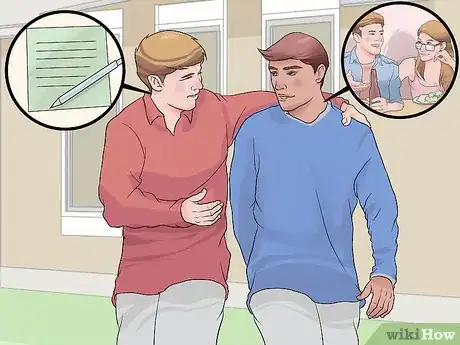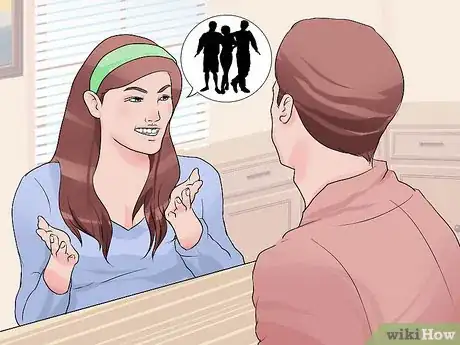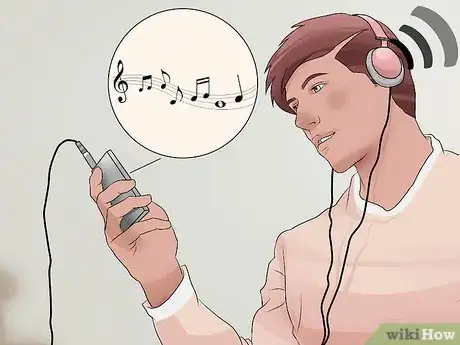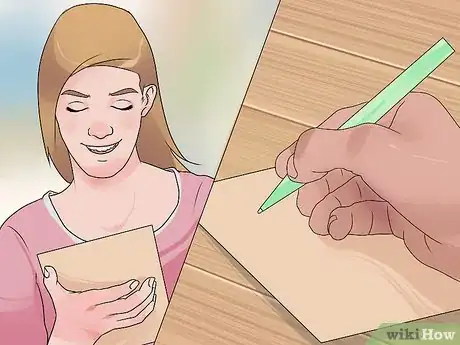This article was co-authored by Meredith Brinster, PhD. Meredith Brinster serves as a Pediatric Developmental Psychologist in the Dell Children’s Developmental and Behavioral Pediatrics Program and as a Clinical Assistant Professor in the Department of Psychiatry and Behavioral Sciences at Dell Medical School of The University of Texas at Austin. With over five years of experience, Dr. Brinster specializes in evaluating children and adolescents with developmental, behavioral, and academic concerns, including autism spectrum disorder, developmental delay, intellectual disability, anxiety, attention problems, and learning disabilities. Her current research focuses on early biomarkers of autism spectrum disorder, as well as improving access to care. Dr. Brinster received her BA in Psychological and Brain Sciences from Johns Hopkins University and her doctorate in Educational Psychology from the University of Texas at Austin. She completed her clinical internship in pediatric and child psychology at the University of Miami Medical School and Mailman Center for Child Development. She is a member of the Society for Research in Child Development (SRCD) and the American Psychological Association (APA).
There are 7 references cited in this article, which can be found at the bottom of the page.
This article has been viewed 1,941,063 times.
Everyone deserves a life full of love. If you are autistic, you may find it particularly difficult to overcome shyness, follow the dating norms of neurotypicals, and overcome the social stigma of autism. However, with perseverance and practice, anyone can have a successful dating life and find a happy partnership with someone who understands what autism really is and what it is not and knows that everyone is unique.[1] [2]
Steps
Meeting a Potential Girlfriend
-
1Meet someone through common interests. One of the simplest way to find potential partners is connecting with people through things you both like to do. This works for both neurotypicals and people on the autistic spectrum.[3]
- One of the main features of people on the autistic spectrum is the "special interest" and it may be either easy or difficult to find somebody that shares your special interest.
- This gives you a built-in conversation starter that is a good foundation for a date.
- Try finding groups doing things you enjoy through websites like Meetup or by taking a local class.
- Think about social activities you already attend. Do you know anyone that you might be interested in developing a relationship?
- Think unconventionally. Social settings don’t have to be physical. Video games, like Minecraft, can be great ways to build community and meet people with similar interests without the pressure of face-to-face first interaction.
-
2Practice reading neurotypical social cues if the woman you are pursuing is neurotypical. Although, ultimately, you want to find someone who accepts your communication style, initially you may need to learn to flirt and understand how to tell if someone is interested.[4]
- Watch television shows and movies to get an idea of these cues but know that these depictions aren’t always realistic.
- Make or feign eye contact for a few seconds, then break it. Try to notice if she seems to be making eye contact with you, as this may mean she likes you.
- Smile slightly. You should smile at the person you like, but make it a small smile, and turn away after a few seconds.
- Act confident. Even when you’re nervous about whether someone likes you, act like you aren’t nervous at all.
Advertisement -
3Find a mentor. Ask a friend, relative, or teacher to help you get ready to date. Pick a friend who has good experience in the dating world. If you're anxious about your conversation skills, you can role-play, or even do a practice date.
- Ask your mentor what they look for in a partner. What are you doing that they would find odd on a date? What would they like? Tell them you appreciate their honesty. Appreciate your friends or mentors advice on how to get a girlfriend.
- It might help to keep a notebook of dating tips.
-
4Consider online dating. When you are autistic, it is often easier to express your feelings in writing than in person. Online dating can be a way to meet like-minded people in an environment that is safe and structured.
- Know what you want in a relationship. Are you looking for something casual or long-term? Be clear about this with yourself so you know how to proceed. Different dating sites suit different needs.
- Decide what dating site is best for you. If you want, there are even websites that match up people on the autism spectrum who would be compatible with each other. This can be a good way to ease some of the stress of reading neurotypical dating cues.
-
5Maintain your appearance. When you start dating, you want to make sure you look your best.
- Bathe regularly and trim your hair and facial hair (if you have any).
- Wear clothes that are clean, ironed, and well-fitting. Don't be afraid to ask a fashion-conscious friend or family member to go shopping with you. They can pick out clothes that enhance your unique attractiveness.
Getting to Know Someone
-
1Start subtle. When you first ask someone out on a date, you want to seem casual so that you don’t come across too formally.
- Simply say something like “Hey would you like to go see a movie on Saturday?”
- Texting or online chat can be a great way to send your initial invitation. Ask your mentor to look over your message before you send it.
-
2Plan out the date. This will help ease your nerves, and let you know what to expect on your date.
- Don’t feel like you have to pick a typical first date if you don’t want to.[5] A bar might be too loud, and going to dinner might put too much pressure on small talk.
- Try an activity-based date. For example, if you like to bowl, invite your date to go bowling with you. When there are gaps in the conversation, you’ll be able to talk about your game. If you enjoy art, take her to an art museum. You’ll be able to talk about the art together, and the setting makes a little silence more acceptable. If you find somebody that shares your special interest, try setting up a date that is related to this special interest.
- Write down the plan for your date. Your date will most likely appreciate the initiative you took to plan it all out and find it romantic.
-
3Let her talk. When you’re on a date, make sure that you let your date talk at least half of the time. As you are listening, nod your head occasionally and interject small statements like “that’s interesting” to let her know that you are actively listening.
- Ask open-ended questions, and if you ask yes or no questions, follow up with something open-ended. For example, if you ask, “Do you have any brothers or sisters?” and she says, “Yes, two older brothers,” say something like, “Oh, what are they like?”
- When your date asks you questions, don’t be too short with your answers but don’t take over the conversation, either.
-
4Find out her favorites. See what kinds of things she likes. What are her favorite movies, books, music, or games? What are her hobbies?
- After she tells you her favorites, go home and check them out. Listen to her favorite song, or read her favorite book. This will give you a better idea of what she’s like, and give you something to talk about on a second date.
-
5Accept rejection if it happens. It’s painful, but remember that everyone goes through it at some point in life. Look around at people on the street. Are all of those people your type? Of course not. It doesn't mean anything is wrong with them; they just aren't right for you. Similarly, you might not be right for her, and that doesn't mean there's anything wrong with you.
- If you are anxious about being rejected, try coming up with a response in advance for rejection, such as saying "Okay, see you around then," and walking away.[6]
- If you ask someone out online or with a written message, silence usually means "no." Don't respond further.
- Don’t give up after one rejection. Move on to someone else. Dating takes persistence. Being rejected just means that you two were a bad match. It doesn't have anything bad to say about you.
Maintaining Your Relationship
-
1Explain your autism. When you feel comfortable, tell her about your disability, and explain how it affects you personally. If you’re dating a neurotypical individual, you’ll need to meet in the middle.
- Be prepared for a few awkward questions. Give honest, factual answers.
- Relationships are about both partners seeking to understand each other. Encourage your girlfriend to use online resources such as Autism Acceptance Month, the Autism Women's Network, and WikiHow to find out more about the autism spectrum.
- Show her that you can be an attentive partner, but sometimes social situations take a lot of effort for you.
-
2Keep boundaries clear. In any relationship, you need to have boundaries, both sexual and nonsexual, and autism can make reading cues like body language difficult.[7] Clearly and non-judgmentally communicate your boundaries to your partner, and ask her to do the same.
- Ask your partner to honestly tell you what makes her uncomfortable and what she would like you not to do in the relationship. Likewise, tell your partner what makes you uncomfortable, as she might not be aware that you don’t like a small gesture from her.
- It might help you both to write these things down on a piece of paper or in a message. It can be easier to come up with boundaries in writing, and you’ll have them to refer back to later.
-
3Give a compassionate response over a pure honest one. When you’re on the autism spectrum, you often value the truth and find it difficult to lie. This can be a good trait, but it may come across as too blunt in certain situations.
- Understand when it is best to give a small "white lie" so as to not hurt your partner’s feelings.
- For example, if your girlfriend comes home with a new dress, puts it on, and asks you if it looks good, you should say, “yes,” even if you don’t think so.
- In this situation, don't think of her question so much like she's asking your opinion of her dress, but more like she's happy in that dress and she's inviting you to share in that happiness with her.
- Furthermore, understand that your partner won’t always be blunt with you. This doesn’t mean that you should tolerate blatant lies, but don’t demand that your partner tell you every detail of her life.
-
4Check in with each other. If you have a difficult time expressing your feelings sometimes, it can be a good idea to have a regular check in session every week. This might be over coffee or dinner.
- Try having a set of questions you always ask. This can be a sweet ritual for you as a couple and a good way to plan to stay in touch. It will make you both feel heard and valued.
- An example set of questions could be:
- What is something I did that made you happy this week?
- What is something I did that made you sad this week?
- What is something you would like us to do together next week?
-
5Make gestures of affection. Consciously think about things you can do to make your girlfriend smile.
- Keep a list in your phone of things your girlfriend likes. If she says one day she likes peonies and a specific kind of chocolate, write it down.
- Every so often, check that list on your phone. Go out and buy her peonies and chocolate for no reason at all.
- Fill the list with details, especially at dates such as Valentine's Day (February 14), their birthday, etc.
-
6Write letters. No matter if you’re on the autism spectrum or not, writing can be a great way to express how you feel to someone.
- Your letters can be hard copies or emails.
- Write down the things you like about your partner and let her read those things.
The normal thing is writing letters in longhand. If you don't have a good handwriting, you can write them in a computer. In that case, use a font that's not so formal such as Brush Script or even Comic Sans.
References
- ↑ http://autisticadvocacy.org/home/about-asan/about-autism/
- ↑ http://www.autismacceptancemonth.com/what-is-autism/
- ↑ https://www.psychologytoday.com/blog/spectrum-solutions/201410/dating-and-autism-free-tips
- ↑ https://www.theatlantic.com/health/archive/2013/08/dating-on-the-autism-spectrum/278340/
- ↑ http://galadarling.com/article/very-definitely-not-dinner-a-movie-50-alternative-first-date-ideas/
- ↑ https://www.carautismroadmap.org/romance-101-dating-for-adults-with-asd/
- ↑ http://www.autismafter16.com/article/09-13-2011/social-life-spectrum










.webp)












